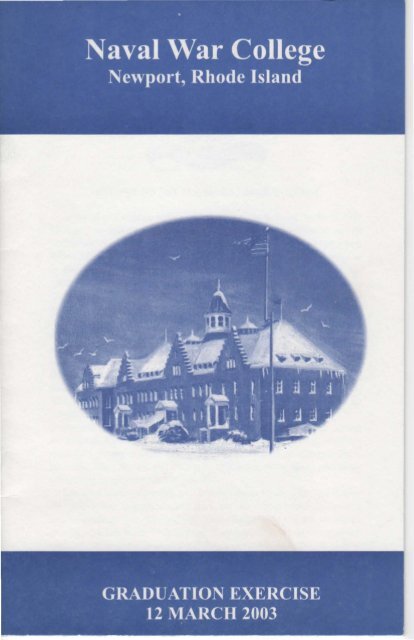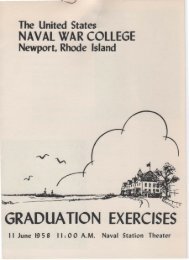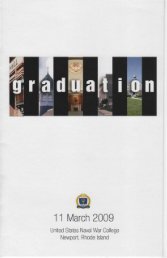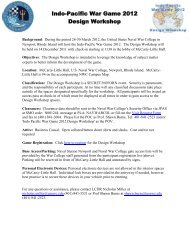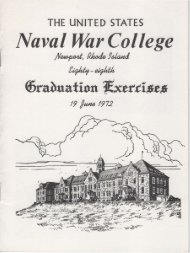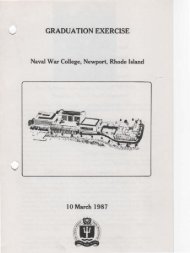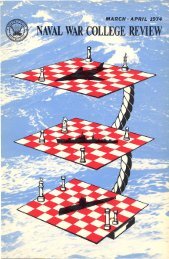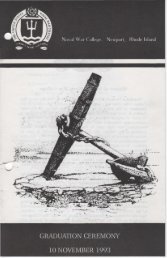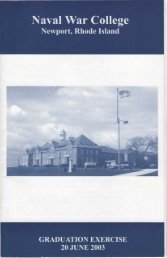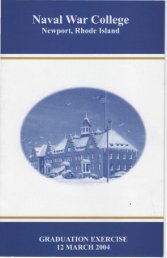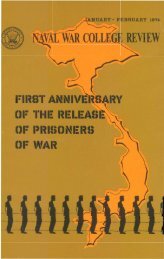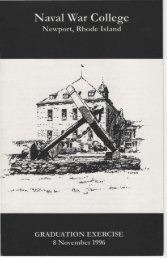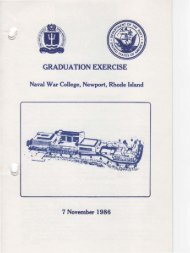You also want an ePaper? Increase the reach of your titles
YUMPU automatically turns print PDFs into web optimized ePapers that Google loves.
HISTORY OF THE U.S. NAVAL WAR COLLEGE<br />
Founded in Newport, Rhode Island on October 6, 1884, the <strong>Naval</strong> <strong>War</strong><br />
<strong>College</strong> is the oldest war college in the nation, and the first military service<br />
institution in the world to be designated a war college. Commodore<br />
Stephen B. Luce was the first president and organized the <strong>War</strong> <strong>College</strong> as<br />
«a place of original research on all questions relating to war and the<br />
statesmanship connected with war, or the prevention of war." These<br />
foundations were built upon by Captain Alfred Thayer Mahan, second<br />
president of the <strong>College</strong>, who had originally been selected by Luce to<br />
initiate the course in <strong>Naval</strong> History. Of all the men who were to influence<br />
the institution in its early years, none was to have a more profound<br />
impact. Mahan's views deeply affected such leaders as Henry Cabot Lodge<br />
and Theodore Roosevelt and through them and others helped shape the<br />
United States' destiny at the turn of the century. Mahan's writings,<br />
published as The Influence of Seapower Upon History, 1660-1783, gained<br />
him worldwide acclaim and established the <strong>Naval</strong> <strong>War</strong> <strong>College</strong> as an<br />
internationally respected institution.<br />
Functioning continuously since 1884, except for brief periods during<br />
the Spanish-American <strong>War</strong> and World <strong>War</strong> I, the <strong>War</strong> <strong>College</strong> numbers<br />
among its graduates such distinguished naval officers as Admirals Sims,<br />
Spruance, King, Nimitz, and Halsey, in addition to many others who today<br />
are holding prominent military positions.<br />
The work begun more than one hundred years ago by Luce and Mahan<br />
continues today. As graduates well know, the curriculum is both demanding<br />
and rewarding. For the military professional, the unique education<br />
provided by the <strong>Naval</strong> <strong>War</strong> <strong>College</strong> is unrivaled. In recognition of the<br />
academic rigor and educational excellence of its <strong>program</strong>, the <strong>Naval</strong> <strong>War</strong><br />
<strong>College</strong> was accredited in 1991 by the New England Association of Schools<br />
and <strong>College</strong>s to award a Master of Arts Degree in National Security and<br />
Strategic Studies.
THE ACADEMIC PROCESSION AND REGALIA<br />
For centuries, institutions of higher learning have dignified their<br />
ceremonies with an academic procession, a custom descending from the<br />
clerical procession. The procession is led by a marshal, followed by the<br />
student body and the academicians or faculty, attired in the robes prescribed<br />
for their respective degrees. Distinguished visitors and delegates follow the<br />
faculty, and last in the procession comes the president of the institution.<br />
Each member of an academic procession ordinarily wears a cap, gown,<br />
and hood. In the procession today military faculty will not wear academic<br />
gowns. The earliest illustration of gowns worn at Oxford University<br />
somewhat resembles cassocks worn by English teachers who found good use<br />
for the hood, or cowl, as protection against the weather. A uniform<br />
American system of academic heraldry displays the level of degree, the field<br />
of study in which it was earned, and the institution by which it was granted.<br />
It is the hood which provides academic regalia its color and offers the most<br />
information about its wearer. The silk lining of the hood bears the color, or<br />
colors, of the degree-granting college or university; its velvet facing reveals the<br />
color assigned to each area of study. The Bachelor's gown is relatively simple,<br />
falling in straight lines from an elaborate yoke and having pointed sleeves. The<br />
Master's gown is slightly more elaborate and fastens about the wrist. The<br />
Doctor's gown is marked by velvet panels down the front and around the<br />
neck, as well as by three bars of the same material on the well-shaped sleeves.<br />
It is cut more fully and may be ornamented. The hood worn is three feet in<br />
length for Bachelors, three and one-half feet for Masters, and four feet for<br />
Doctorates, with velvet trimming of two, three, and five inches in width<br />
respectively.<br />
The edging, or facing, velvet of academic hoods indicates the area of study.<br />
The principal scholarly fields seen in the procession today include:<br />
Philosophy<br />
Arts, Letters, Humanities<br />
Business Administration<br />
Economics<br />
Engineering<br />
Law<br />
International Affairs/Public Administration<br />
Dark Blue<br />
White<br />
Light Brown<br />
Copper<br />
Orange<br />
Purple<br />
Peacock Blue<br />
The American mortarboard, derived from the soft Oxford cap, is black.<br />
Its tassel, for holders of the bachelor's and master's degree, is usually black,<br />
while gold tassels are worn by holders of doctoral degrees and heads of<br />
institutions. The tassel is worn on the right side of the cap by undergraduates,<br />
on the left by holders of bachelor's and higher degrees.
PROGRAM<br />
Music by Navy Band Northeast<br />
Procession of Students<br />
Procession of Faculty<br />
Arrival of Official Party*<br />
National Anthem*<br />
Invocation""<br />
Captain Robert D. Evans, CHC, U.S. Navy<br />
Welcome<br />
Rear Admiral Rodney P. Rempt, U.S. Navy<br />
President, <strong>Naval</strong> <strong>War</strong> <strong>College</strong><br />
Graduation Address<br />
The Honorable David S. C. Chu<br />
Under Secretary of Defense for Personnel and Readiness<br />
""Guests please stand<br />
Recognition of Honor Graduates<br />
Presentation of Diplomas<br />
Charge to Graduates<br />
Rear Admiral Rodney P. Rempt, U.S. Navy<br />
President, <strong>Naval</strong> <strong>War</strong> <strong>College</strong><br />
Benediction *<br />
Captain Robert D. Evans, CHC, U.S. Navy
THE HONORABLE DAVID S. C. CHU<br />
UNDER SECRETARY OF DEFENSE FOR<br />
PERSONNEL AND READINESS<br />
David S. C. Chu was sworn in as the Under<br />
Secretary of Defense for Personnel and Readiness on<br />
June 1,2001. A Presidential appointee confirmed by<br />
the Senate, he is the Secretary's senior policy advisor<br />
on recruitment, career development, pay and<br />
benefits for 1.4 million active duty military<br />
personnel, 1.3 million Guard and Reserve personnel and 680,000 DoD civilians<br />
and is responsible for overseeing the state of military readiness.<br />
The Under Secretary of Defense for Personnel and Readiness also oversees the<br />
$15 billion Defense Health Program, Defense Commissaries and Exchanges with<br />
$14.5 billion in annual sales, the Defense Education Activity which supports over<br />
100,000 students, and the Defense Equal Opportunity Management Institute, the<br />
nation's largest equal opportunity training <strong>program</strong>.<br />
Dr. Chu earlier served in government as the Director and then Assistant<br />
Secretary of Defense (Program Analysis and Evaluation) from May 1981 to<br />
January 1993. In that capacity, he advised the Secretary of Defense on the future<br />
size and structure of the armed forces, their equipment, and their preparation for<br />
crisis or contlict.<br />
From 1978 to 1981, Dr. Chu served as the Assistant Director for National<br />
Security and International Affairs, Congressional Budget Office, providing advice<br />
to the Congress on the full range of national security and international economic<br />
Issues.<br />
Dr. Chu began his service to the nation in 1968 when he was commissioned<br />
in the Army and became an instructor at the U.S. Army Logistics Management<br />
Center, Fort Lee VA. He later served a tour of duty in the Republic of Vietnam,<br />
working in the Office of the Comptroller, Headquarters, 1st Logistical<br />
Command. He obtained the rank of captain and completed his service with the<br />
Army in 1970.<br />
Prior to rejoining the Department of Defense, Dr. Chu served in several senior<br />
executive positions with RAND, including Director of the Arroyo Center, the<br />
Army's federally funded research and development center for studies and analysis<br />
and Director of RAND's Washington Office.<br />
Dr. Chu received a Bachelor of Arts Degree, magna cum laude, in<br />
Economics and Mathematics from Yale University in 1964 and a Doctorate in<br />
Economics, also from Yale, in 1972. He is a fellow of the National Academy of<br />
Public Administration and a recipient of its National Public Senior Award. He<br />
holds the Department of Defense Medal for Distinguished Public service with<br />
silver palm.
REAR ADMIRAL RODNEY P. REMPT, U.S. NAVY<br />
PRESIDENT, NAVAL WAR COLLEGE<br />
Rear Admiral Rempt was raised in the Los Angeles<br />
suburb of Van Nuys and graduated from the U.S.<br />
<strong>Naval</strong> Academy with the Class of 1966. He holds<br />
Masters Degrees in Systems Analysis from Stanford<br />
University and in National Security and Strategic<br />
Studies from the <strong>Naval</strong> <strong>War</strong> <strong>College</strong>. Initial<br />
assignments at sea included deployments to Vietnam<br />
aboard <strong>US</strong>S COONTZ (DLG-9) and <strong>US</strong>S SOMERS<br />
(DDG-34). His first sea command was <strong>US</strong>S ANTELOPE (PG 86), one of four<br />
missile-armed patrol gunboats homeported in Naples, Italy.<br />
Rear Admiral Rempt commanded <strong>US</strong>S CALLAGHAN (DDG 994) during two<br />
WESTPAC/Indian Ocean deployments, and the <strong>US</strong>S BUNKER HILL (CG 52)<br />
homeported in Yokosuka, Japan. While on BUNKER HILL, Rear Admiral Rempt<br />
served for 18 months as the Anti-Air <strong>War</strong>fare Commander (AA WC) for<br />
SEVENTH Fleet.<br />
Duties ashore included three years in the Weapon Prototyping office of the <strong>Naval</strong><br />
Sea Systems Command as the initial project officer for the MK 41 Vertical Launch<br />
system, on the CNO's Staff as Program Coordinator for the AEGIS Weapon System,<br />
as the Director of the PCO/PXO department at the Surface <strong>War</strong>fare Officers Schools<br />
Command in Newport and as the Director, Anti-Air <strong>War</strong>fare Requirements<br />
Division (OP-75) on the CNO's staff. Rear Admiral Rempt also worked in the<br />
Ballistic Missile Defense Organization (BMDO) where he initiated the development<br />
of <strong>Naval</strong> Theater Ballistic Missile Defense (TBMD) and then continued those efforts<br />
as Director, Theater Air Defense (N865) on the CNO's staff.<br />
In July 1996 Rear Admiral Rempt assumed duties as Program Executive<br />
Officer, Theater Air Defense (PEO TAD) , additionally serving as the U.S. Steering<br />
Committee Member for the NATO Seasparrow and RoBing Airframe Missile<br />
multi national <strong>program</strong>s. In May 1998 Rear Admiral Rempt was assigned as the<br />
first Deputy Assistant Secretary of the Navy for Theater Combat Systems where he<br />
was the principle advisor on the introduction of <strong>Naval</strong> TBMD and the<br />
development of advanced shipboard combat systems. [n June 2000, Rear Admiral<br />
Rempt was assigned as the first Assistant Chief of <strong>Naval</strong> Operations for Missile<br />
Defense. In September of that year, Rear Admiral Rempt additionally relieved as<br />
Director, Surface <strong>War</strong>fare (N76), responsible for all Surface <strong>War</strong>fare people<br />
initiatives, ship <strong>program</strong>s and combat systems. He assumed duties as the 48 th<br />
President of the <strong>Naval</strong> <strong>War</strong> <strong>College</strong> on 22 August 2001.<br />
His personal awards include the Legion of Merit (Third award), the<br />
Meritorious Service Medal (Third award), and the Navy Commendation Medal<br />
(Third award with Combat "V").
COLLEGE OF NAVAL WARFARE<br />
Commander John M. Andersen, U.S. Navy<br />
Commander Gregory S. Anderson, U.S. <strong>Naval</strong> Reserve<br />
Commander Matthew E. Baker, U.S. Navy<br />
Dr. George C. Barcus, Department of the Navy<br />
Commander John J. Braunschweig, U.S. Navy<br />
Commander Gerald H. Br"iggs, Jr., U.S. Navy<br />
Commander George R. Davidson, Jr., U.S. Navy<br />
Commander Gary H. Foster, U.S. Navy<br />
Captain Stephen G. Gabriele, U.s. Navy<br />
Commander Jeffrey D. Gordon, U.s. Navy<br />
Commander David M. J-Iaynes, U.S. <strong>Naval</strong> Reserve<br />
Commander Peter R. Jannotta, U.s. Navy<br />
Captain David A. J9nes, U.S. Navy<br />
Commander Debra M. Livingood, U.S. Navy<br />
Commander Maria Lyles, U.S. Navy<br />
Colonel Michael J. Mallory, U.S. Army<br />
Commander Victor R. Mattes, U.S. Navy<br />
Commander Francis R. McCulloch, U.S. Navy<br />
Commander Steven A. McLaughlin, U.S. Navy<br />
Commander Dan W. Monette, U.S. Navy<br />
Commander Eugene P. Potente, U.S. Navy<br />
Commander Craig A. Richey, U.S. Navy<br />
Commander John R. Rumbaugh, MSC, U.S. Navy<br />
Captain Bradley B. Smith, U.S. Navy<br />
Commander Paul S. Webb, U.S. Navy<br />
Commander Mary K. Wesslen, U.S. Navy
Lieutenant Commander Daniel G. Robertson, U.S. Navy<br />
Lieutenant Commander Christopher A. Rodeman, U.S. Navy<br />
Lieutenant Commander Jon D. Schaab, SC, U.S. Navy<br />
Commander John P. Springett, U.S. Navy<br />
Lieutenant Commander Timothy S. Steadman, U.S. Navy<br />
Lieutenant Commander David M. Trzeciakiewicz, U.S. Navy<br />
Lieutenant Commander Peter N. Turner, U.S. Navy<br />
Lieutenant Commander William A. Weedon, U.S. Navy<br />
Lieutenant Commander George G. Wilson, U.S. Navy<br />
Lieutenant Commander Christopher S. Wiseman, U.S. Navy<br />
COLLEGE OF DISTANCE EDUCATION<br />
Lieutenant Commander Anita C. Bacher, NC, U.S. <strong>Naval</strong> Reserve<br />
Mr. Russell E. Bryant, Jr., Program Executive Office for Integrated<br />
<strong>War</strong>fare Systems<br />
Lieutenant Louis O. Carl, U.S. <strong>Naval</strong> Reserve<br />
Lieutenant Commander Yvette M. Davids, U.S. Navy<br />
Mr. Julio S. de la Cruz, <strong>Naval</strong> Air Systems Command<br />
Lieutenant Commander Victor D. De La Ossa. MSC, U.S. Navy<br />
Mr. Robert T. Frazier, <strong>Naval</strong> Sea Systems Command<br />
Lieutenant Commander Richard G. Froderman, U.S. Navy Reserve<br />
Major Matthew F. Houser, U.S. Army<br />
Commander Michael W. Lutche, U.S. Navy<br />
Lieutenant Commander Regina A. McNamara, U.S. Coast Guard<br />
Commander Dayne E. Nix, CHC, U.S. Navy<br />
Commander Troy A. Stoner, U.S. Navy
Semper Paratus<br />
(U.S. Coast Guard)<br />
We're always ready for the call,<br />
We place our trust in Thee.<br />
Through surf and storm and howling gale,<br />
High shall our purpose be.<br />
Semper Paratus" is our guide,<br />
Our fame at1d glory too.<br />
To fight to save or fight to die,<br />
Aye! Coast Guard we are for you!<br />
Marine Corps Hymn<br />
(U.S. Marine Corps)<br />
From the Halls of Montezuma<br />
To the Shores of Tripoli<br />
We fight our country's battles<br />
111 the air, on land and sea;<br />
First to fight for right and freedom<br />
And to keep our honor clean;<br />
We are proud to claim the title<br />
of United States Maril1e.
The Air Force Song<br />
(U.S. Air Force)<br />
Off we go into the wild blue yonder<br />
Climbing high into the sun;<br />
Here they come zooming to meet our thunder,<br />
At'em boys, giv'er the gun! (Giv'er the gun!)<br />
Down we dive spouting our flames from under,<br />
Off with one hell-of-a roar!<br />
We live in fame or go down in flame ... Hey!<br />
Nothing'll stop the U.S. Air Force!<br />
The Caissons Go Rolling Along<br />
(U.S. Army)<br />
First to fight for the right<br />
And to build the nation's might,<br />
And the Army goes rolling along.<br />
Proud of all we have done<br />
Fighting till the battle's won,<br />
And the Army goes rolling along.<br />
Then it's Hi! Hi! Hey!<br />
The Army's on its way.<br />
Count off the cadence loud and strong.<br />
For where' er we go, you will always know,<br />
. That the Army goes rolling along.
Anchors Aweigh<br />
(U.S. Navy)<br />
Anchors A weigh, my boys,<br />
Anchors A weigh.<br />
Farewell to foreign shores,<br />
We sail at break of day-ay-ay-ay.<br />
Through our last night on shore,<br />
Drink to the foam,<br />
Until we meet once more:<br />
Here's wishing you a happy voyage home.<br />
National Anthem-Fourth Verse<br />
Oh! thus be it ever, when freemen shall stand<br />
Between their loved homes and the war's desolation!<br />
Blest with victory and peace, may the heaven-rescued land<br />
Praise the Power that hath made and preserved us a nation.<br />
Then conquer we must, when our cause it is just,<br />
And this be our motto: "In God is our trust."<br />
And the star-spangled banner in triumph shall wave<br />
O'er the land of the free and the home of the brave!
UNITED STATES NAVAL WAR COLLEGE<br />
COAT OF ARMS<br />
The wavy white and blue bars at the bottom<br />
of the shield represent water. The trident rising from<br />
it symbolizes mastery of naval activities. The three<br />
tines of the trident allude to an understanding of naval<br />
warfare at sea, in the air, and on land. The pilot wheel<br />
alludes to the mission of the <strong>Naval</strong> <strong>War</strong> <strong>College</strong>, education in<br />
naval warfare. The eight spokes refer to honor, duty,<br />
leadership, command, strategy, tactics, logistics, and weapons.<br />
The laurel wreath is for achievement of the mission. The<br />
motto is "Victory Through Sea Power."


